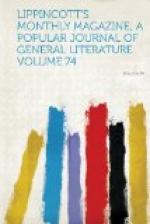and clever enough, but they are wanting in the individuality
and in the completeness of the genuine Short-story.
Like the brief tales to be seen in the English monthly
magazines and in the Sunday editions of American newspapers
into which they are copied, they are, for the most
part, either merely amplified anecdotes or else incidents
which might have been used in a Novel just as well
as not. Now, the genuine Short-story abhors the
idea of the Novel. It can be conceived neither
as part of a Novel nor as elaborated and expanded
so as to form a Novel. A good Short-story is
no more the synopsis of a Novel than it is an episode
from a Novel. A slight Novel, or a Novel cut down,
is a Novelette: it is not a Short-story.
Mr. Howells’s “Their Wedding Journey”
and Miss Howard’s “One Summer” are
Novelettes, although an American editor, who had offered
a prize for a list of the ten best Short-stories,
allowed them to be included. Mr. Anstey’s
“Vice Versa,” Mr. Besant’s “Case
of Mr. Lucraft,” and Mr. Hugh Conway’s
“Called Back” are Short-stories in conception,
although they are without the compression which the
Short-story requires. In the acute and learned
essay on
vers de societe which Mr. Frederick
Locker prefixed to his admirable “Lyra Elegantiarum,”
he declared that the two characteristics of the best
vers de societe were brevity and brilliancy,
and that “The Rape of the Lock” would
be the type and model of the best
vers de societe—if
it were not just a little too long. So it is with
“The Case of Mr. Lucraft,” with “Vice
Versa,” with “Called Back:”
they are just a little too long.
It is to be noted as a curious coincidence that there
is no exact word in English to designate either vers
de societe or the Short-story, and yet in no language
are there better vers de societe or Short-stories
than in English. It may be remarked also that
there is a certain likeness between vers de societe
and Short-stories: for one thing, both seem easy
and are hard to write. And the typical qualifications
of each may apply with almost equal force to the other:
vers de societe should reveal compression,
ingenuity, and originality, and Short-stories should
have brevity and brilliancy. In no class of writing
are neatness of construction and polish of execution
more needed than in the writing of vers de societe
and of Short-stories. The writer of Short-stories
must have the sense of form, which Mr. Lathrop has
called “the highest and last attribute of a
creative writer.” The construction must
be logical, adequate, harmonious. Here is the
weak spot in Mr. Bishop’s “One of the
Thirty Pieces,” the fundamental idea of which
has extraordinary strength perhaps not fully developed
in the story. But others of Mr. Bishop’s
stories—“The Battle of Bunkerloo,”
for instance—are admirable in all ways,
conception and execution having an even excellence.
Again, Mr. Hugh Conway’s “Daughter of the
Stars” is a Short-story which fails from sheer




